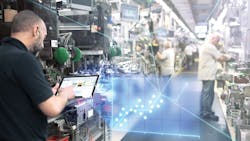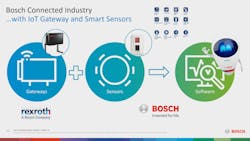Digitalized Manufacturing: How to Combat Productivity Disruptions
The coronavirus pandemic is a case study in reacting flexibly to productivity disruptions—one that highlights the value of connected manufacturing and logistics during exceptional times. To survive, manufacturing and logistics look to agile solutions and applications that can improve connectivity to help track individual machines in real time.
For many, investing in software during times of crises will make no sense. At the same time, doing nothing is not an option. But machine tools expert Heiko Schwindt will have you know that the way to proceed is to move ahead with those digitalization plans, particularly if they were included in last year’s strategic plan and can be implemented in a pared-down capacity.
During a presentation on digitalized manufacturing (Hannover Messe Digital Days, July 14-15), Schwindt, vice president, Sales, Bosch Connected Industry, outlined three reasons digitalization is beneficial:
- Reduced contact. Sending information remotely on how to maintain or how to repair a machine can reduce contact among maintenance experts.
- High transparency. When factories are running at full speed, higher transparency helps, as it provides a way to see in advance whether a factory is expecting downtime or anticipates bottlenecks and other issues.
- High flexibility. When plants or factories emerge from lockdown situations, digitalization can help factories ramp up or ramp down production.
“We are running our machines longer and longer,” said Schwindt. “The normal runtime of a machine was 15 years. Now it goes up to 25 years, and we talk about a second life of a machine. And, because of the current situation, companies want to breathe life into their machines—a third life. So, we are possibly running machines until they are 35 years old.”
The question is, how do we connect legacy machines?
Schwindt explained that his Bosch Connected Industry business unit—which was founded in 2018 and focuses on Industry 4.0 software and services—is benefiting from tried-and-tested experience running 245 manufacturing sites worldwide. The company is using its competence in optimizing manufacturing by harnessing its proprietary internal software solutions for condition monitoring and flow management systems.
During the virtual event, Bosch rolled out its Nexeed Industrial Application System, which offers data-collection software applications that can be used across individual lines or across plant networks. Data collected from the machine, using a Rexroth IoT Gateway, communicate with intelligent wireless sensors, and in turn send information on temperature, vibration and humidity to the cloud via gateways.
Also integral to Bosch’s broader vision is being able to leverage 5G, wireless, real-time capability to allow companies to set IIoT goals and develop flexible manufacturing setups so plants can add assembly capacity or technology as required. (Bosch Rexroth debuted its software-based, 5G-capable control technology, ctrlX Automation, in a separate presentation during the virtual event.)
Together, these applications will facilitate communication between machines—whether it occurs at the machine, assembly line or robot level. The complete software infrastructure can help companies build “now, next and beyond” scenarios on a path to the factory of the future, Schwindt said.
Optimization Potential
When it comes to IIoT implementations in practice, some of Schwindt’s clients have stated that they don’t know “where the path is through the jungle.” His advice? “Start smart and think big.”
However, his advice comes with a caveat: Companies embarking on a digital journey should know at the outset exactly what they want to get back in their return on investment. “I have been involved in several proof of concepts over the years, and my personal [take] is the challenge of the Industrial Internet of Things is to create real value—in dollars and euros,” said Schwindt.
While proof of concept (PoC) is the starting point, he noted, it’s more important to know what the “proof of return on investment” (PoR) will be when starting IIoT installations, or when achieving a higher degree of digitalization in manufacturing is the goal.
Software applications ought to be adaptable to the task at hand. To this end, Schwindt explained how Bosch is tailoring its software applications to be ordered, used and connected with one another as needed, regardless of whether it is for shop-floor management (for managing error statistics, ticket management or line KPIs) or machine equipment (condition monitoring).
The data collected are interchangeable between the applications and ensure continuous flow of information, he continued, adding that ticket management can be directly connected to error statistics or to the condition monitoring system. The application can automatically create tickets for maintenance experts, “and this could avoid contact at the moment.”
In one example, Bosch is implementing its solutions at BMW. The dispensing project in the final assembly of the cockpit entails bringing transparency across the system, from the robot dispensing the glue or foam to the assembly line. By analyzing the runtime of the foam or glue injectors, productivity can be increased by 15%, and the team can derive actions to maintain the injectors during the planned downtime.
For Schwindt, getting data from the machine and processing it so it can be visualized on a dashboard is “not rocket science.” A software development platform can foster higher levels of transparency that allows a plant to digitalize the entire value chain, he said.
What’s essential, Schwindt advised, is taking a holistic approach and understanding the true value of the return on investment from an IIoT installation.
About the Author

Rehana Begg
Editor-in-Chief, Machine Design
As Machine Design’s content lead, Rehana Begg is tasked with elevating the voice of the design and multi-disciplinary engineer in the face of digital transformation and engineering innovation. Begg has more than 24 years of editorial experience and has spent the past decade in the trenches of industrial manufacturing, focusing on new technologies, manufacturing innovation and business. Her B2B career has taken her from corporate boardrooms to plant floors and underground mining stopes, covering everything from automation & IIoT, robotics, mechanical design and additive manufacturing to plant operations, maintenance, reliability and continuous improvement. Begg holds an MBA, a Master of Journalism degree, and a BA (Hons.) in Political Science. She is committed to lifelong learning and feeds her passion for innovation in publishing, transparent science and clear communication by attending relevant conferences and seminars/workshops.
Follow Rehana Begg via the following social media handles:
X: @rehanabegg
LinkedIn: @rehanabegg and @MachineDesign





